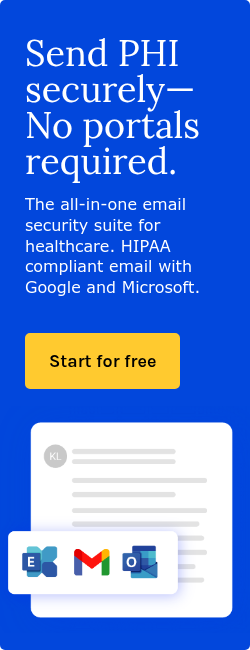4 min read
Why HIPAA compliant email is a useful part of growing patient lists
Kirsten Peremore
April 15, 2025

According to the BMC Health Services Research study ‘Direct Marketing in Health and Medicine: Using Direct Mail, Email Marketing, and Related Communicative Methods to Engage Patients, “In pursuing viable patient streams, communication proficiencies are essential, affording health and medical establishments with the ability to engage, inform, and attract current and prospective customers.”
Email campaigns act as a conduit for direct marketing by allowing organizations to maintain direct communication with current and prospective patients, offering tailored messages that resonate with their needs and preferences. Organizations can collect email addresses through online signup forms on their websites or social media platforms, ensuring ease of access and incentivizing registration with offers such as free guides or newsletters. Personalized emails, such as appointment reminders or health recommendations based on user behavior, support a sense of connection.
To maximize effectiveness, healthcare organizations can look to tools for list management and automation. These tools help maintain clean email lists, automate follow-ups, and ensure timely delivery of information such as appointment reminders or seasonal health tips. By combining proven techniques with continuous evaluation of campaign performance metrics, healthcare providers can refine their strategies to achieve sustained growth in their client base.
Importance of a client/patient list in healthcare
Expanding client lists is necessary to ensure organizational growth and adaptability to evolving healthcare demands. With increasing shortages of healthcare providers globally, attracting new patients is not guaranteed unless organizations actively market their services and build trust.
The BMC study previously mentioned notes, “Patient acquisition and retention activities constitute some of the most important tasks conducted by health and medical establishments. Inabilities to attract and retain patients carry consequences well beyond the walls of given healthcare establishments, extending deeply into markets and even impacting community health.”
A larger client base enables diversification of revenue streams through innovative services such as telemedicine or specialized treatments, while also reducing risks associated with over-reliance on existing patients. Expanding the list helps organizations reach underserved populations and establish themselves as leaders in their field. Strategies like community engagement, referral programs, and leveraging technology can contribute to this expansion.
The value of consistent communication in patient satisfaction and retention
A journal article Patient Satisfaction Associated with Increased Patient Retention published in the Malahayati International Journal of Nursing and Health Science notes, “Patient satisfaction is a very important asset because if patients are satisfied, then they will continue to use the service they have chosen...Patient satisfaction is also one of the first indicators of hospital standards and service quality measures.”
When healthcare providers engage in clear, empathetic, and regular communication, patients are more likely to feel valued and understood, which strengthens their relationship with the organization. The study goes on to express that “patient satisfaction can be achieved through 5 dimensions of satisfaction, which are the main indicators that influence service quality according to the SerQual service quality concept, namely direct evidence (tangibles), reliability, responsiveness, assurance and empathy.”
Effective communication helps patients comprehend their medical conditions, treatment plans, and follow-up requirements, empowering them to make informed decisions about their care. Consistent communication assists in managing patient expectations and addressing concerns quickly.
Proactive updates on test results or appointment reminders via secure messaging systems show attentiveness and reliability. These practices reduce the likelihood of dissatisfaction and position the organization as patient-centered and responsive.
Building and growing the email list
A paper titled Building Your First Profitable List states, “Building your list of email contacts and using that list to promote your products, services or ideas is still the easiest, most cost-effective and most user-friendly ways to connect with a large group of prospective customers, clients or fans.”
Healthcare organizations could leverage their existing patient interactions to encourage email list sign-ups. This can be achieved through means like opt-in forms on their website, ensuring that these forms are HIPAA compliant. Offering valuable resources such as health tips or access to exclusive content can incentivize patients to subscribe to email lists.
Healthcare providers can use email to improve patient engagement and retention by sending personalized communications. Studies have shown that patients often prefer email for non-urgent communications, as it provides a convenient and private means of discussing health issues. However, it is necessary to ensure that emails are composed clearly and professionally.
Paubox Marketing to expand email lists
Paubox Marketing offers healthcare organizations a powerful and HIPAA compliant solution to expand client lists through personalized email campaigns. The platform’s intelligent drip campaign functionality further enhances its effectiveness by automating workflows based on user actions, such as email opens or link clicks. This ensures that recipients receive timely and relevant follow-up communications, nurturing them through the care journey. Additionally, Paubox’s drag-and-drop email design builder simplifies the creation of visually appealing campaigns, making it easy for marketers to craft engaging messages without requiring technical expertise.
Why HIPAA should be a consideration when growing patient lists
The Seminars in Hearing study, Digital Marketing for Private Practice: How to Attract New Patients recommends that in cases where email is used with patients, “The individual responsible for collecting online reviews could use a HIPAA compliant email service to send out email invites, as well as follow-ups and reminders, with links to the appropriate platforms.”
HIPAA requires healthcare providers to secure protected health information (PHI) by implementing security meet compliance standards. These measures are necessary because email, while an effective tool for outreach, is one of the most vulnerable channels for data breaches. For example, human errors like sending PHI to the wrong recipient or failing to encrypt sensitive data can lead to severe penalties, as seen in recent high-profile cases where violations cost organizations millions of dollars in fines and settlements.
Beyond avoiding legal repercussions, prioritizing HIPAA compliance improves patient trust. Patients expect their sensitive information to be handled responsibly, and any breach can erode confidence in the organization’s ability to provide care. By using HIPAA compliant email platforms with encryption and limiting the inclusion of PHI in communications, healthcare organizations can demonstrate their commitment to privacy.
FAQs
What does it mean for an email to be HIPAA compliant?
HIPAA compliant email refers to emails that use encryption protocols for data at rest and in transit, ensure that only authorized personnel can access sensitive information, and include secure authentication.
How can healthcare organizations measure the success of their email marketing campaigns?
Success can be measured by tracking open rates, click-through rates, conversion rates, and patient retention. Regular analysis and optimization of campaigns based on these metrics help refine strategies and improve outcomes.
How often should healthcare organizations send emails to maintain engagement without overwhelming patients?
Frequency depends on the audience, but a general rule is to avoid sending emails too often (e.g., daily) or too infrequently (e.g., quarterly). A monthly newsletter combined with timely updates about services or appointments often works well.
How can email marketing help retain existing patients while attracting new ones?
For existing patients, email campaigns can provide reminders for appointments and follow-ups or offer loyalty rewards. For new patients, promotional offers and educational content can showcase the organization’s expertise and services.
Subscribe to Paubox Weekly
Every Friday we'll bring you the most important news from Paubox. Our aim is to make you smarter, faster.




